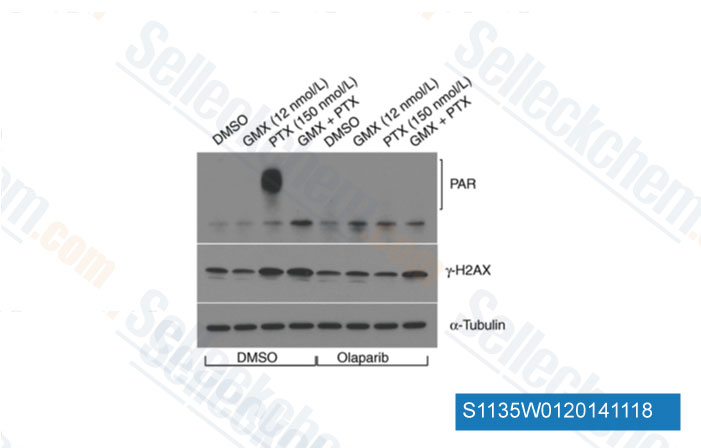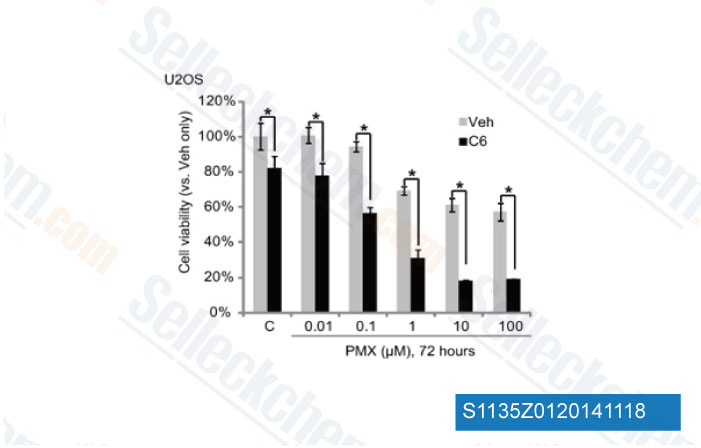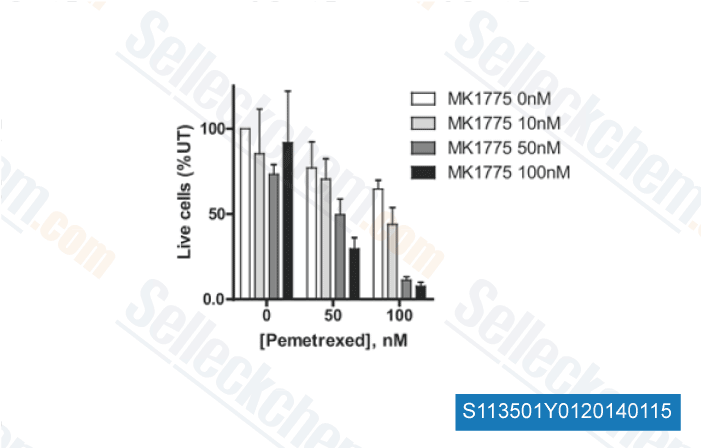|
Toll Free: (877) 796-6397 -- USA and Canada only -- |
Fax: +1-832-582-8590 Orders: +1-832-582-8158 |
Tech Support: +1-832-582-8158 Ext:3 Please provide your Order Number in the email. |
Technical Data
| Formula | C20H19N5Na2O6 |
||||||
| Molecular Weight | 471.37 | CAS No. | 150399-23-8 | ||||
| Solubility (25°C)* | In vitro | Water | 94 mg/mL (199.41 mM) | ||||
| DMSO | Insoluble | ||||||
| Ethanol | Insoluble | ||||||
| In vivo (Add solvents to the product individually and in order) |
|
||||||
|
* <1 mg/ml means slightly soluble or insoluble. * Please note that Selleck tests the solubility of all compounds in-house, and the actual solubility may differ slightly from published values. This is normal and is due to slight batch-to-batch variations. * Room temperature shipping (Stability testing shows this product can be shipped without any cooling measures.) |
|||||||
Preparing Stock Solutions
Biological Activity
| Description | Pemetrexed disodium is a novel antifolate and antimetabolite for TS, DHFR and GARFT with Ki of 1.3 nM, 7.2 nM and 65 nM in cell-free assays, respectively. Pemetrexed induces autophagy and apoptosis. | ||||||
|---|---|---|---|---|---|---|---|
| Targets |
|
||||||
| In vitro | Pemetrexed disodium shows the antiproliferative activity in CCRF-CEM leukemia, GC3/C1 colon carcinoma, and HCT-8 ileocecal carcinoma cells with IC50 of 25 nM, 34 nM and 220 nM, respectively. [1] A recent study shows that cisplatin plus Pemetrexed combined with SOCS-1 gene delivery shows the antitumor effect by inhibition of cell proliferation, invasiveness, and induction of apoptosis in MPM cells infected with adenovirus-expressing SOCS-1 vector. [2] | ||||||
| In vivo | In the human H460 non-small cell lung carcinoma xenograft, Pemetrexed disodium produces a duration-dependent tumor growth delay (TGD). [3] |
Protocol (from reference)
| Kinase Assay:[1] |
|
|---|---|
| Cell Assay:[1] |
|
| Animal Study:[3] |
|
References
|
Customer Product Validation

-
Data from [Data independently produced by Cancer Res, 2014, 74(21), 5948-54]

-
Data from [Data independently produced by Biochem Biophys Res Commun, 2014, 452(1), 72-8]

-
Data from [Data independently produced by Mol Cancer Ther, 2013, 12, 2675-84]
Selleck's Pemetrexed disodium has been cited by 44 publications
| PD-L1 induces autophagy and primary resistance to EGFR-TKIs in EGFR-mutant lung adenocarcinoma via the MAPK signaling pathway [ Cell Death Dis, 2024, 15(8):555] | PubMed: 39090096 |
| Olanzapine suppresses mPFC activity-norepinephrine releasing to alleviate CLOCK-enhanced cancer stemness under chronic stress [ Cell Commun Signal, 2024, 22(1):375] | PubMed: 39054537 |
| MPS1 inhibition primes immunogenicity of KRAS-LKB1 mutant lung cancer [ Cancer Cell, 2022, 40(10):1128-1144.e8] | PubMed: 36150391 |
| CDK/cyclin dependencies define extreme cancer cell-cycle heterogeneity and collateral vulnerabilities [ Cell Rep, 2022, 38(9):110448] | PubMed: 35235778 |
| Establishment and large-scale validation of a three-dimensional tumor model on an array chip for anticancer drug evaluation [ Front Pharmacol, 2022, 13:1032975] | PubMed: 36313330 |
| A study of protein-drug interaction based on solvent-induced protein aggregation by fluorescence correlation spectroscopy [ Analyst, 2022, 10.1039/d2an00031h] | PubMed: 35253833 |
| The novel mechanism of Med12-mediated drug resistance in a TGFBR2-independent manner [ Biochem Biophys Res Commun, 2022, 610:1-7] | PubMed: 35461070 |
| A Novel Molecular Target in EGFR-mutant Lung Cancer Treated With the Combination of Osimertinib and Pemetrexed [ Anticancer Res, 2022, 42(2):709-722] | PubMed: 35093869 |
| Arachidonic acid drives adaptive responses to chemotherapy-induced stress in malignant mesothelioma [ J Exp Clin Cancer Res, 2021, 40(1):344] | PubMed: 34727953 |
| Essential role of the histone lysine demethylase KDM4A in the biology of malignant pleural mesothelioma (MPM) [ Br J Cancer, 2021, 10.1038/s41416-021-01441-7] | PubMed: 34088988 |
RETURN POLICY
Selleck Chemical’s Unconditional Return Policy ensures a smooth online shopping experience for our customers. If you are in any way unsatisfied with your purchase, you may return any item(s) within 7 days of receiving it. In the event of product quality issues, either protocol related or product related problems, you may return any item(s) within 365 days from the original purchase date. Please follow the instructions below when returning products.
SHIPPING AND STORAGE
Selleck products are transported at room temperature. If you receive the product at room temperature, please rest assured, the Selleck Quality Inspection Department has conducted experiments to verify that the normal temperature placement of one month will not affect the biological activity of powder products. After collecting, please store the product according to the requirements described in the datasheet. Most Selleck products are stable under the recommended conditions.
NOT FOR HUMAN, VETERINARY DIAGNOSTIC OR THERAPEUTIC USE.
